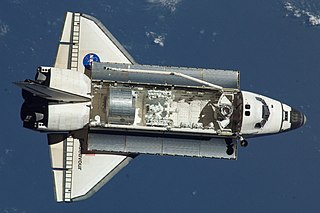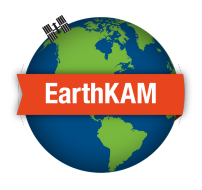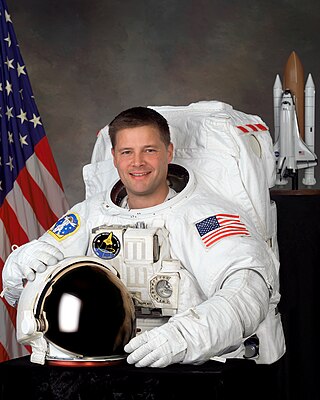
An astronaut is a person trained, equipped, and deployed by a human spaceflight program to serve as a commander or crew member aboard a spacecraft. Although generally reserved for professional space travelers, the term is sometimes applied to anyone who travels into space, including scientists, politicians, journalists, and tourists.

The International Space Station (ISS) is the largest modular space station in low Earth orbit. The project involves five space agencies: the United States' NASA, Russia's Roscosmos, Japan's JAXA, Europe's ESA, and Canada's CSA. The ownership and use of the space station is established by intergovernmental treaties and agreements. The station serves as a microgravity and space environment research laboratory in which scientific research is conducted in astrobiology, astronomy, meteorology, physics, and other fields. The ISS is suited for testing the spacecraft systems and equipment required for possible future long-duration missions to the Moon and Mars.

Space Shuttle Atlantis is a Retired Space Shuttle orbiter vehicle which belongs to NASA, the spaceflight and space exploration agency of the United States. Atlantis was manufactured by the Rockwell International company in Southern California and was delivered to the Kennedy Space Center in Eastern Florida in April 1985. Atlantis is also the fourth operational and the second-to-last Space Shuttle built. Its maiden flight was STS-51-J made from October 3 to 7, 1985.

Space Shuttle Endeavour is a retired orbiter from NASA's Space Shuttle program and the fifth and final operational Shuttle built. It embarked on its first mission, STS-49, in May 1992 and its 25th and final mission, STS-134, in May 2011. STS-134 was expected to be the final mission of the Space Shuttle program, but with the authorization of STS-135 by the United States Congress, Atlantis became the last shuttle to fly.

The Space Shuttle program was the fourth human spaceflight program carried out by the U.S. National Aeronautics and Space Administration (NASA), which accomplished routine transportation for Earth-to-orbit crew and cargo from 1981 to 2011. Its official name, Space Transportation System (STS), was taken from a 1969 plan for a system of reusable spacecraft of which it was the only item funded for development. It flew 135 missions and carried 355 astronauts from 16 countries, many on multiple trips.

Richard Allen Garriott de Cayeux is an American video game developer, entrepreneur and private astronaut. Although both his parents were American, he maintains dual British and American citizenship by birth.

Space Adventures, Inc. is an American space tourism company founded in 1998 by Eric C. Anderson. Its offerings include zero-gravity atmospheric flights, orbital spaceflights, and other spaceflight-related experiences including cosmonaut training, spacewalk training, and launch tours. Plans announced thus far include sub-orbital and lunar spaceflights, though these are not being actively pursued at present. Nine of its clients have participated in the orbital spaceflight program with Space Adventures, including one who took two separate trips to space.

Yury Valentinovich Lonchakov is a Russian former cosmonaut and a veteran of three space missions. He has spent 200 days in space and has conducted two spacewalks. From 2014 to 2017, Lonchakov served as head of the Yuri Gagarin Cosmonaut Training Center.

Owen Kay Garriott was an American electrical engineer and NASA astronaut, who spent 60 days aboard the Skylab space station in 1973 during the Skylab 3 mission, and 10 days aboard Spacelab-1 on a Space Shuttle mission in 1983.

Michael Landon Gernhardt is a NASA astronaut and manager of the Environmental Physiology Laboratory, and principal investigator of the Prebreathe Reduction Program (PRP) at the Lyndon B. Johnson Space Center.

Scott Edward Parazynski is an American physician and a former NASA astronaut. A veteran of five Space Shuttle flights and seven spacewalks, Parazynski's latest mission was STS-120 in October 2007 – highlighted by a dramatic, unplanned EVA to repair a live solar array. In May 2016 he was inducted into the United States Astronaut Hall of Fame. He retired from NASA in March 2009 to pursue entrepreneurial opportunities in the private sector, and he is currently the CEO of a technology start-up. He is the first person to have both flown in space and summited Mount Everest, the highest point on Earth.

Edward Michael "Mike"/"Spanky" Fincke is an American astronaut who formerly held the American record for the most time in space. His record was broken by Scott Kelly on October 16, 2015.

The Destiny module, also known as the U.S. Lab, is the primary operating facility for U.S. research payloads aboard the International Space Station (ISS). It was berthed to the Unity module and activated over a period of five days in February, 2001. Destiny is NASA's first permanent operating orbital research station since Skylab was vacated in February 1974.

Sally Ride EarthKAM is a NASA educational outreach program started in 1996. The program was initiated by JoBea Way Holt, an Earth scientist from NASA's Jet Propulsion Laboratory, and was initially named KidSat. It allowed students to direct a digital camera aboard a series of space shuttle flights to take photographs of specific places on Earth. In 1998, KidSat was co-opted Dr. Sally Ride, the first American woman in space and renamed EarthKAM. Dr. Ride directed the installation of camera equipment on the International Space Station (ISS), where it became a permanent fixture independent of shuttle flights.

Douglas Harry "Wheels" Wheelock is an American engineer and astronaut. He has flown in space twice, logging 178 days on the Space Shuttle, International Space Station, and Russian Soyuz. On July 12, 2011, Wheelock announced that he would be returning to active duty with the United States Army in support of Operation Enduring Freedom. He is currently working with NASA to test the Orion spacecraft at the Glenn Research Center in Plum Brook, Ohio.

Soyuz TMA-12 was a Soyuz mission to the International Space Station (ISS) which was launched by a Soyuz FG rocket at 11:16 UTC on 8 April 2008. It docked to the Pirs module of the station on 10 April 2008. Landing occurred at 03:37 on 24 October. It was the first nominal landing in three missions, following separation failures on the Soyuz TMA-10 and 11 spacecraft.

Gregory Errol Chamitoff is a Canadian-born American engineer and former NASA astronaut. He has been to space twice, spending 6 months aboard the ISS across Expedition 17 and 18 in 2008, and another 15 days as part of STS-134 in 2011. STS-134 was the last of Space Shuttle Endeavour which delivered the Alpha Magnetic Spectrometer and completed the US Orbital Segment.

Sergey Aleksandrovich Volkov is a retired Russian cosmonaut and engineer. He was a member of three missions to the International Space Station, spending more than a year in total in space. During his missions he did four spacewalks lasting more than 23 hours in total. Volkov retired from the Cosmonaut group in February 2017.

The National Aeronautics and Space Administration is an independent agency of the U.S. federal government responsible for the civil space program, aeronautics research, and space research.

A Beautiful Planet is a 2016 American documentary film directed, written, and produced by Toni Myers, and narrated by actress Jennifer Lawrence. It was originally released exclusively for IMAX theatres. Created in cooperation with the National Aeronautics and Space Administration (NASA), the documentary utilizes footage recorded by astronauts aboard the International Space Station (ISS) over the course of fifteen months. The documentary examines how astronauts live and work on a daily basis. The astronauts are representing the respective space agencies of the United States, Russia, Europe, and Japan.






















